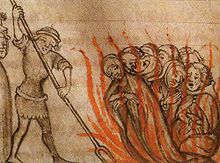
| Part of a series on the |
| Knights Templar |
|---|
 |
|
Poor Fellow-Soldiers of Christ and of the Temple of Solomon |
| Overview |
| Councils |
| Papal bulls |
|
| Locations |
| Successors |
| Cultural references |
| See also |
|
|
In 1307, members of the Knights Templar in the Kingdom of France were suddenly charged with heresy and arrested after their leader, Master Jacques de Molay, had recently come to France for meetings with Pope Clement V.[1] Many, including their leader, were burned at the stake while others were sentenced to perpetual imprisonment. The events in France led to a series of trials in other locations, not all of which had the same outcome.
The Templars traced their beginnings to the Latin Kingdom of Jerusalem in c. 1120 when nine Christian knights, under the auspices of King Baldwin II and the Patriarch Warmund, were given the task of protecting pilgrims on the roads to Jerusalem, which they did for nine years until elevated to a military order at the Council of Troyes in 1129. They became an elite fighting force in the Crusades known for their propensity not to retreat or surrender.
Eventually, their rules of secrecy, their power, privileges and their wealth,[a] made them vulnerable to Philip IV of France's accusations and, with the Pope's unsuccessful attempts to prevent it, their destruction.
- ^ Field, Sean L. (April 2016). Jansen, Katherine L. (ed.). "Torture and Confession in the Templar Interrogations at Caen, 28–29 October 1307". Speculum: A Journal of Medieval Studies. 91 (2). Chicago: University of Chicago Press on behalf of the Medieval Academy of America: 297–327. doi:10.1086/684916. ISSN 2040-8072. JSTOR 43883958. LCCN 27015446. OCLC 35801878. S2CID 159457836.
Cite error: There are <ref group=lower-alpha> tags or {{efn}} templates on this page, but the references will not show without a {{reflist|group=lower-alpha}} template or {{notelist}} template (see the help page).